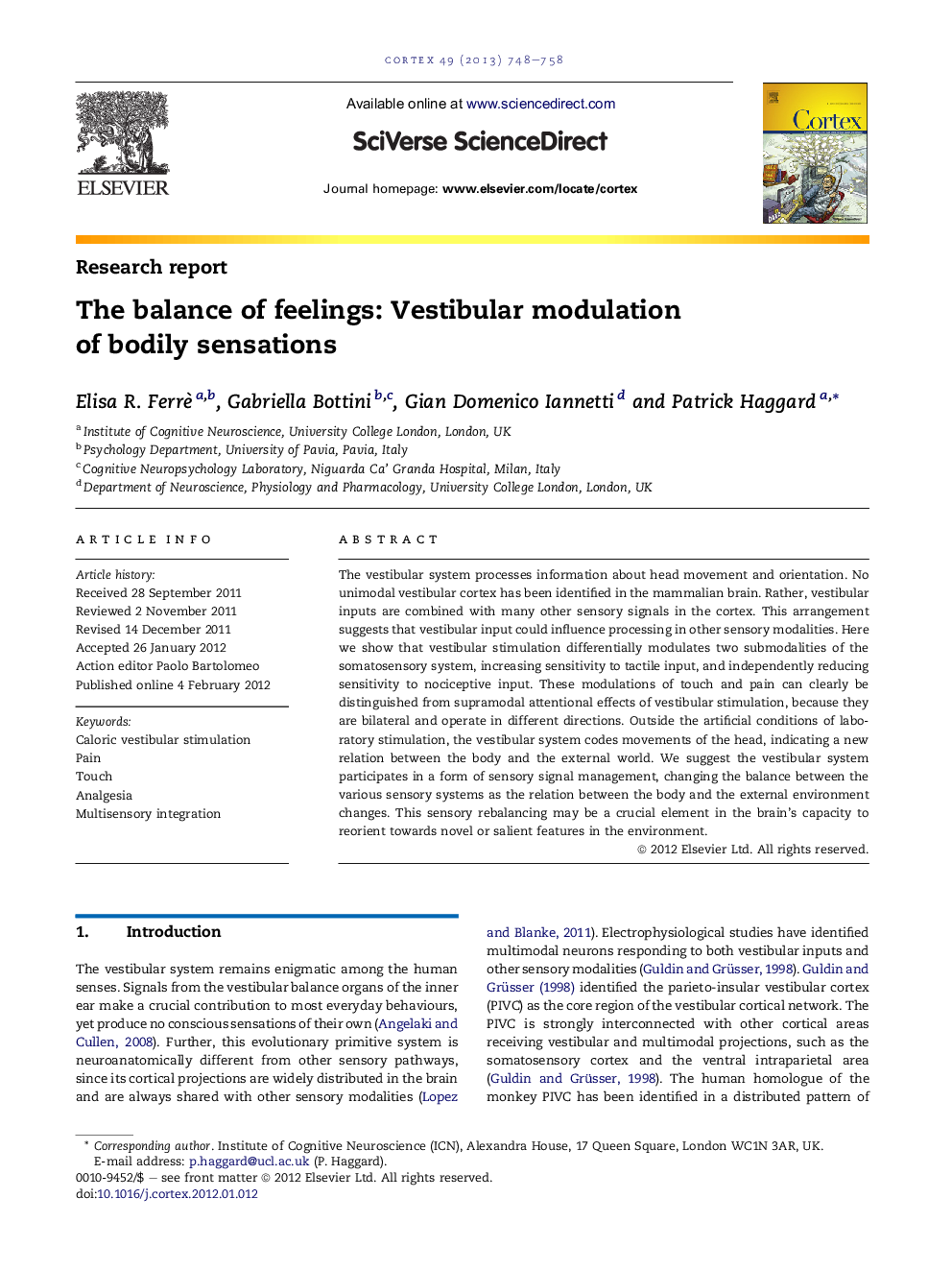| کد مقاله | کد نشریه | سال انتشار | مقاله انگلیسی | نسخه تمام متن |
|---|---|---|---|---|
| 10463219 | 925109 | 2013 | 11 صفحه PDF | دانلود رایگان |
عنوان انگلیسی مقاله ISI
The balance of feelings: Vestibular modulation of bodily sensations
ترجمه فارسی عنوان
تعادل احساسات: مدولاسیون وستیبولی از احساسات بدنی
دانلود مقاله + سفارش ترجمه
دانلود مقاله ISI انگلیسی
رایگان برای ایرانیان
کلمات کلیدی
تحریک غدد لنفاوی کالری، درد، دست زدن به، بی اشتهایی یکپارچه سازی چند جانبه،
ترجمه چکیده
سیستم ویستیبولار اطلاعات مربوط به حرکت سر و جهت گیری را پردازش می کند. در مغز پستانداران هیچ یک از قشر غدد مجاری تناسلی وجود ندارد. در عوض، ورودی های ویستیبولار با بسیاری از سیگنال های حسی دیگر در قشر مغز ترکیب می شوند. این ترتیب نشان می دهد که ورودی وستیبولار می تواند بر پردازش در سایر حالت های حسی تاثیر بگذارد. در اینجا ما نشان می دهیم که تحریک وستیبول به طور متفاوتی دو زیرمجموعه سیستم سموتوسنسوری را مدول می کند، حساسیت به ورودی لمسی را افزایش می دهد و به طور مستقل کاهش حساسیت به ورودی غیرواقعی. این تغییرات لمس و درد به وضوح می تواند از تأثیرات متمرکز بر توجهات تحریک وستبولار متمایز شود، زیرا آنها دوجانبه هستند و در جهت های مختلف عمل می کنند. در خارج از شرایط مصنوعی تحریک آزمایشگاهی، سیستم وستی بیضه حرکات سر را نشان می دهد، نشان دهنده ارتباط جدید بین بدن و دنیای خارج است. ما پیشنهاد می کنیم سیستم ویستیبولار در قالب مدیریت سیگنال حسی شرکت می کند و تعادل بین سیستم های حسی مختلف را تغییر می دهد به عنوان رابطه بین بدن و تغییرات محیط خارجی. این تعادل متعادل کننده حساسیت ممکن است یک عنصر حیاتی در توانایی مغز در جهت بازگشت به ویژگی های جدید یا برجسته در محیط باشد.
موضوعات مرتبط
علوم زیستی و بیوفناوری
علم عصب شناسی
علوم اعصاب رفتاری
چکیده انگلیسی
The vestibular system processes information about head movement and orientation. No unimodal vestibular cortex has been identified in the mammalian brain. Rather, vestibular inputs are combined with many other sensory signals in the cortex. This arrangement suggests that vestibular input could influence processing in other sensory modalities. Here we show that vestibular stimulation differentially modulates two submodalities of the somatosensory system, increasing sensitivity to tactile input, and independently reducing sensitivity to nociceptive input. These modulations of touch and pain can clearly be distinguished from supramodal attentional effects of vestibular stimulation, because they are bilateral and operate in different directions. Outside the artificial conditions of laboratory stimulation, the vestibular system codes movements of the head, indicating a new relation between the body and the external world. We suggest the vestibular system participates in a form of sensory signal management, changing the balance between the various sensory systems as the relation between the body and the external environment changes. This sensory rebalancing may be a crucial element in the brain's capacity to reorient towards novel or salient features in the environment.
ناشر
Database: Elsevier - ScienceDirect (ساینس دایرکت)
Journal: Cortex - Volume 49, Issue 3, March 2013, Pages 748-758
Journal: Cortex - Volume 49, Issue 3, March 2013, Pages 748-758
نویسندگان
Elisa R. Ferrè, Gabriella Bottini, Gian Domenico Iannetti, Patrick Haggard,
